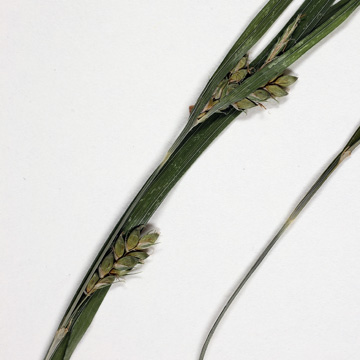

Carex grisea - (image 1 of 5)
Taxonomy
Family: Cyperaceae
Section Griseae
Synonymous with C. amphibola var. turgida
Habitat
Woods, flood plains, swampy or upland forests. In NY usually found in neutral to calcareous woods surrounding riparian areas.
Associates
Distribution
New Brunswick and Quebec to VA, TN and MS, west SD to TX.
Morphology
Tufted perennial; stems 20-90 cm; basal sheaths red-purple to rarely brown; leaves (3.7-)4.2-8.2(-9.1) mm wide; peduncles and axis of inflorescence mostly smooth; terminal spike staminate, sessile or nearly so, usually surpassing the uppermost pistillate one; pistillate spikes 2-4, 5-31 mm long, loosely flowered with 3-19 mostly widely spaced perigynia, the lowest near the middle of the stem on exsert peduncles, the upper on shorter peduncles; pistillate scales ovate, 4-8.2 mm long, entire, white-margined and often with red-brown speckles, the mid vein of the lower prolonged into an awn 0.9-5.3 mm; perigynia spirally imbricate, ellipsoid to obovoid, rounded to quite obtusely trigonous in cross section, 4.2-5.3 mm long and (1.8-)2-2.6 mm wide, gradually tapered to the base and apex, finely many-nerved, with a straight beak to 0.2 mm or beakless; achenes trigonous, broadly obovoid to obovoid.
Notes
Fruiting May to July
Wetland indicator: FAC
Similar to C. amphibola but the perigynia more rounded in cross section and less narrow (1.8-2.6 times as long as wide), (1.8-)2-2.6 mm wide and the achene also more stout (1.7-2.2 mm wide) on shorter stipes mostly 0.3-0.4 mm long.
References
Ball, P.W. and A.A. Reznicek. 2002. Carex, In: Flora of North America Editorial Committee, Eds. Flora of North America North of Mexico. Volume 23. Oxford University Press, New York.
Gleason, Henry A. and A. Cronquist. 1991. Manual of Vascular Plants of
Northeastern United States and Adjacent Canada. Second Ed.
The New York Botanical Garden. Bronx, NY
|
© Michael Hough 2018 |